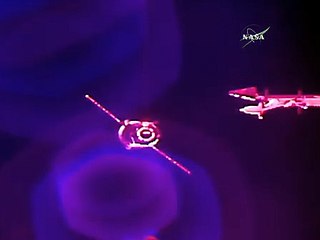
The State Corporation for Space Activities "Roscosmos", commonly known simply as Roscosmos, is a state corporation of the Russian Federation responsible for space flights, cosmonautics programs, and aerospace research.

The Almaz program was a highly secret Soviet military space station program, begun in the early 1960s.
The Tsyklon, GRAU index 11K67, was a Soviet-designed expendable launch system, primarily used to put Cosmos satellites into low Earth orbit in the late-1960s. It is based on the R-36 intercontinental ballistic missile designed by Mikhail Yangel and made eight launches, with seven successes and one failure. All of its launches were conducted from LC-90 at the Baikonur Cosmodrome. It is sometimes designated Tsyklon-2A, not to be confused with the later Tsyklon-2 rocket. It was introduced in 1967 and was derived from the R-36 ICBM. It was retired in 1969.

The Angara rocket family is a family of launch vehicles being developed by the Moscow-based Khrunichev State Research and Production Space Center. The launch vehicles are to put between 3,800 kg (8,400 lb) and 24,500 kg (54,000 lb) into low Earth orbit and are intended, along with Soyuz-2 variants, to replace several existing launch vehicles.

NPO Mashinostroyeniya is a rocket design bureau based in Reutov, Russia. During the Cold War it was responsible for several major weapons systems, including the UR-100N Intercontinental ballistic missile and the military Almaz space station program.
Meridian 1, also known as Meridian No.11L, was a Russian communications satellite. It was the first satellite to be launched as part of the Meridian system to replace the older Molniya series.

Soyuz 2 is a modernized expendable medium-lift launch vehicle and the seventh major version of the Soyuz rocket family. It includes key enhancements over its predecessors including improved engines along with digital flight control and telemetry systems, enabling launches from fixed platforms and the use of large payload fairings.

Persona is a class of Russian reconnaissance satellites, derived from the Resurs DK class of remote sensing satellite, in turn derived from the Soviet Yantar reconnaissance satellites. The satellites are built by TsSKB-Progress, and the optics by LOMO and the Vavilov State Optical Institute.
Strela is a Russian orbital carrier rocket, derived from the Soviet/Russian UR-100NU missile. It conducted its maiden test launch on 5 December 2003, carried its first functional payload on 27 June 2013, and a second one on 19 December 2014.
China plans to launch eleven Huanjing satellites for disaster and environmental monitoring. The satellites will be capable of visible, infrared, multi-spectral and synthetic-aperture radar imaging.

The RD-253 (Russian: Ракетный Двигатель-253 (РД-253), romanized: Raketnyy Dvigatel-253, lit. 'Rocket Engine-253') and its later variants, the RD-275 and RD-275M, are liquid-propellant rocket engines developed in the Soviet Union by Energomash. The engines are used on the first stage of the Proton launch vehicle and use an oxidizer-rich staged combustion cycle to power the turbopumps. The engine burns UDMH/N2O4, which are highly toxic but hypergolic and storable at room temperature, simplifying the engine's design.

Rus-M was a proposed launcher design which was intended to become Russia's main launch vehicle for crewed spaceflight after 2018, and an integral part of the Orel spacecraft being developed to replace the Soyuz.

Elektro–L is a series of meteorological satellites developed for the Russian Federal Space Agency by NPO Lavochkin. The first satellite, Elektro-L No.1, was launched on 2 January 2011. It is the first Russian weather satellite that successfully operates in geostationary orbit, and is currently the second operational Russian weather satellite. The satellites have a mass of about 1620 kg and are designed to operate for 10 years each. They are capable of producing images of the Earth's whole hemisphere in both visible and infrared frequencies, providing data for climate change and ocean monitoring in addition to their primary weather forecasting role.

Elektro-L No.1, also known as Geostationary Operational Meteorological Satellite No.2 or GOMS No.2, is a Russian geostationary weather satellite which was launched in 2011. The first Elektro-L spacecraft to fly, it became the first Russian geostationary weather satellite to be launched since Elektro No.1 in 1994.
The Blok DM-03, GRAU index 11S861-03, is a Russian upper stage used as an optional fourth stage on the Proton-M and Angara A5 heavy-lift rockets. Three have been launched, the first in December 2010; the first two launches failed before fourth stage ignition, the first as a result of a problem with the Blok DM's fuel load. Some versions are also known as Orion.

EgyptSat 2 was Egypt's second remote sensing Earth observation satellite. It was built by the Russian RSC Energia and the Egyptian NARSS while the incorporated cameras and payload was developed by OAO Peleng and NIRUP Geoinformatsionnye Sistemy in Belarus.

Progress MS-06, identified by NASA as Progress 67P, was a Progress spaceflight operated by Roscosmos to resupply the International Space Station (ISS). It was launched on 14 June 2017.
Kometa Corporation is an enterprise of the Russian military-industrial complex specializing in the research, development, production and operation of space information management and intelligence systems.











